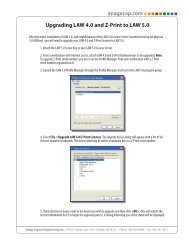Getting Started Guide - LexisNexis
Getting Started Guide - LexisNexis
Getting Started Guide - LexisNexis
You also want an ePaper? Increase the reach of your titles
YUMPU automatically turns print PDFs into web optimized ePapers that Google loves.
GETTING STARTED GUIDE I LAW PREDISCOVERY <br />
OCR<br />
The optical character recognition (OCR) process will create a text file for each of the selected image<br />
records, providing enhanced searching and retrieval capabilities when fed into the target application<br />
following LAW PreDiscovery. The OCR process can be quite time consuming. This time is dependent<br />
on the quality of the originals, the type of data on the page and the amount of data.<br />
Regarding Unicode and OCR: the Expervision and TextBridge OCR engines do not currently support Unicode.<br />
To find supported languages, go to the Tools menu and select Options. Click the OCR tab and click the<br />
down arrow to open the Language pull-down menu. Printed and extracted text will contain Unicode data<br />
if it exists in the original file and can be displayed, provided the proper language pack(s) are installed on<br />
the system.<br />
Print (Standard-Image Only)<br />
This process prints the selected images (no native files, see E-Print) to the printer specified in<br />
Options > Print Options. If a header and/or footer is specified, you can apply it to the image at this time<br />
by selecting Yes to the prompt that appears before printing begins.<br />
Regarding Unicode and Print: the Text/RTF Printer does not support Unicode text files. It supports rich text<br />
files with Unicode. This is a limitation of the underlying component. To print Unicode text files, use either<br />
Microsoft Word or the Shell Printer as the source application. If you use the Shell Printer, you must ensure<br />
that the application registered on the system for text files supports shell prints. For example, Notepad<br />
supports shell prints.<br />
E-Print (ED-Native Files)<br />
This process is used to print native files stored in LAW PreDiscovery to paper. Use the print batch process<br />
to print documents along with images associated with them. Use the E-Print Options to configure settings<br />
for this process.<br />
Scan for Suspect Footers<br />
This feature scans all pages for suspect footers (those appearing to be 1 inch or larger) and flags an index field<br />
of your choosing with Y if any pages in a document contain suspect footers, N if not. This feature is useful<br />
if images that have been imported already contained an endorsement and the documents were endorsed<br />
again, creating a double endorsement.<br />
CHAPTER 7<br />
49



